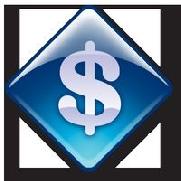
 |
|
| Financial Terms | |
| Plus |
|
Information about financial, finance, business, accounting, payroll, inventory, investment, money, inventory control, stock trading, financial advisor, tax advisor, credit.
Main Page: inventory, payroll, business, credit, tax advisor, accounting, investment, financial, |
Definition of Plus
Plusealers in government bonds normally give price quotes in 32nds. To quote a bid or offer in 64ths, they
Related Terms:Capital surplusAmounts of directly contributed equity capital in excess of the par value. Economic surplusFor any entity, the difference between the market value of all its assets and the market Regulatory surplusThe surplus as measured using regulatory accounting principles (RAP) which may allow Statutory surplusThe surplus of an insurance company determined by the accounting treatment of both Surplus fundsCash flow available after payment of taxes in the project. Surplus managementRelated: asset management Cost-plus pricingA method of pricing in which a mark-up is added to the total product/service cost.  cost-plus contracta contract in which the customer agrees surplus variablea variable used in a linear programming problem that represents overachievement of a minimum requirement; it is associated with greater-than-or-equal-to constraints Cost Plus Estimated Earnings in Excess of BillingsRevenue recognized to date under the percentage-of-completion method in excess of amounts billed. Also known as unbilled accounts Surplus inventoryParts for which the on-hand quantity exceeds forecasted PLUS systemA bank machine network outside Canada, across the U.S. and internationally. Customers who use a bank machine with a 'plus' symbol may be charged a fee. Adjusted present value (APV)The net present value analysis of an asset if financed solely by equity Annual percentage yield (APY)The effective, or true, annual rate of return. The APY is the rate actually ARMAdjustable rate mortgage. A mortgage that features predetermined adjustments of the loan interest rate Asset/liability managementAlso called surplus management, the task of managing funds of a financial  BasisRegarding a futures contract, the difference between the cash price and the futures price observed in the Book profitThe cumulative book income plus any gain or loss on disposition of the assets on termination of the SAT. Call money rateAlso called the broker loan rate , the interest rate that banks charge brokers to finance Capital asset pricing model (CAPM)An economic theory that describes the relationship between risk and Cash flow after interest and taxesNet income plus depreciation. Cash flow from operationsA firm's net cash inflow resulting directly from its regular operations Common stock/other equityValue of outstanding common shares at par, plus accumulated retained Control50% of the outstanding votes plus one vote. Convention statementAn annual statement filed by a life insurance company in each state where it does Debt serviceInterest payment plus repayments of principal to creditors, that is, retirement of debt. Debt-service coverage ratioEarnings before interest and income taxes plus one-third rental charges, divided  Documented discount notesCommercial paper backed by normal bank lines plus a letter of credit from a Dollar-weighted rate of returnAlso called the internal rate of return, the interest rate that will make the Economic incomeCash flow plus change in present value. Effective call priceThe strike price in an optional redemption provision plus the accrued interest to the Enhanced indexingAlso called indexing plus, an indexing strategy whose objective is to exceed or replicate Expected returnThe return expected on a risky asset based on a probability distribution for the possible rates Financial leverageUse of debt to increase the expected return on equity. Financial leverage is measured by Fisher effectA theory that nominal interest rates in two or more countries should be equal to the required real Fixed-charge coverage ratioA measure of a firm's ability to meet its fixed-charge obligations: the ratio of Gross national product (GNP)Measures and economy's total income. It is equal to GDP plus the income Group of seven (G7/G-7)The G-5 countries plus Canada and Italy. Money baseComposed of currency and coins outside the banking system plus liabilities to the deposit money banks. Money supplyM1-A: Currency plus demand deposits Net cash balanceBeginning cash balance plus cash receipts minus cash disbursements. Net worthCommon stockholders' equity which consists of common stock, surplus, and retained earnings. OptionGives the buyer the right, but not the obligation, to buy or sell an asset at a set price on or before a Overfunded pension planA pension plan that has a positive surplus (i.e., assets exceed liabilities). Stockholder equityBalance sheet item that includes the book value of ownership in the corporation. It Take-outA cash surplus generated by the sale of one block of securities and the purchase of another, e.g. Total debt to equity ratioA capitalization ratio comparing current liabilities plus long-term debt to Underfunded pension planA pension plan that has a negative surplus (i.e., liabilities exceed assets). Variance ruleSpecifies the permitted minimum or maximum quantity of securities that can be delivered to CASH AND CASH EQUIVALENTSThe balance in a company’s checking account(s) plus short-term or temporary investments (sometimes called “marketable securities”), which are highly liquid. Cost basisAn asset’s purchase price, plus costs associated with the purchase, like installation fees, taxes, etc. RETAINED EARNINGSProfits a company plowed back into the business over the years. Last January’s retained earnings, plus the net income or profit that a company made this year (which is calculated on the income statement), minus dividends paid out, equals the retained earnings balance on the balance sheet date. Accounting equationThe representation of the double-entry system of accounting such that assets are equal to liabilities plus capital. Return on capital employed (ROCE)The operating profit before interest and tax as a percentage of the total shareholders’ funds plus EquityAmounts contributed to the company by the owners (contributed capital) plus the residual earnings of the business (retained earnings). cost of capitalRefers to the interest cost of debt capital used by a business owners' equityRefers to the capital invested in a business by its shareowners profitThe general term profit is not precisely defined; it may refer to net Continuous CompoundingThe process of continuously adding interest to a principal plus Discrete CompoundingThe process of adding interest to a principal plus interest amount Operating Cash FlowIncome available after the payment of taxes, plus the value of the cycle timethe time between the placement of an order to purchasing costthe quoted price of inventory minus any Correlation coefficientA statistic in which the covariance is scaled to a Actual costThe actual expenditure made to acquire an asset, which includes the supplierinvoiced Average inventoryThe beginning inventory for a period, plus the amount at the end of Book inventoryThe amount of money invested in inventory, as per a company’s CapitalThe investment by a company’s owners in a business, plus the impact of any additional paid-in capitalDifference between issue price and par value of stock. Also called capital surplus. internally generated fundsCash reinvested in the firm; depreciation plus earnings not paid out as dividends. net worthBook value of common stockholders’ equity plus preferred stock. Labor ForceThose people employed plus those actively seeking work. M2Broad measure of money, consisting of M1 plus various deposits that are less substitutable with cash. Money BaseCash plus deposits of the commercial banks with the central bank. National SavingPrivate saving plus public saving. That part of national income which is not spent on consumption goods or government spending. Official Settlements AccountAn account within the balance of payments accounts showing the change in a country's official foreign exchange reserves. It is used to measure a balance of payments deficit or surplus. PrincipalThe original amount loaned, which is repaid plus interest. See face value. SterilizationCentral bank action offsetting money supply changes automatically generated by a balance of payments surplus or deficit under a fixed exchange rate system. Unbilled Accounts ReceivableRevenue recognized under the percentage-of-completion DividendAs the term dividend relates to a corporation's earnings, a dividend is an amount paid per share from a corporation's after tax profits. Depending on the type of share, it may or may not have the right to earn any dividends and corporations may reduce or even suspend dividend payments if they are not doing well. Some dividends are paid in the form of additional shares of the corporation. Dividends paid by Canadian corporations qualify for the dividend tax credit and are taxed at lower rates than other income. Insured Retirement PlanThis is a recently coined phrase describing the concept of using Universal Life Insurance to tax shelter earnings which can be used to generate tax-free income in retirement. The concept has been described by some as "the most effective tax-neutralization strategy that exists in Canada today." ReinstatementThis is the restoration of a lapsed life insurance policy. The life insurance company will require evidence of continuing good health and the payment of all past due premiums plus interest. Cash FlowIn investments, NET INCOME plus DEPRECIATION and other noncash charges. In this sense, it is synonymous with CASH EARNINGS. Investors focus on cash flow from operations because of their concern with a firm's ability to pay dividends. EquityThe net worth of a business, consisting of capital stock, capital (or paid-in) surplus (or retained earnings), and, occasionally, certain net worth reserves. Common equity is that part of the total net worth belonging to the common shareholders. Total equity includes preferred shareholders. The terms common stock, net worth, and common equity are frequently used interchangeably. spousal RRSP (Canada)The RRSP rules allow you to contribute to an RRSP for your spouse and claim the deduction yourself. Your total contribution (to your own and your spouse's plan) is still subject to your normal contribution limits, minus any personal pension adjustment and any past service pension adjustment, plus any unused contribution room from prior years and any pension adjustment reversal. Generally, the advantage is that your spouse will ultimately be the one who reports the income for tax purposes when the funds are withdrawn on retirement or otherwise (certain restrictions apply). If your spouse will have a lower income than you when the funds are withdrawn, significantly lower taxes may be payable on the withdrawn amount. Accumulated ValueAn amount of money invested plus the interest earned on that money. DividendUnlike dividends which are paid to company shareholders, participating insurance policy dividends are not based on the company's overall profits. Rather, they are determined by grouping policies by type and country of issue and looking at how each class contributes to the company's earnings and surplus. Related to : financial, finance, business, accounting, payroll, inventory, investment, money, inventory control, stock trading, financial advisor, tax advisor, credit. |